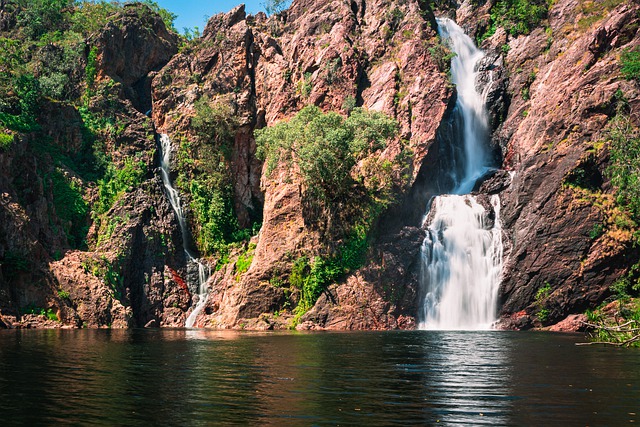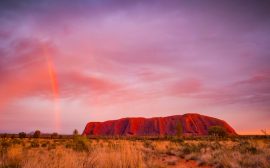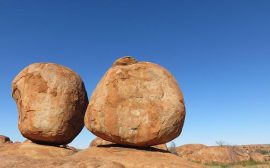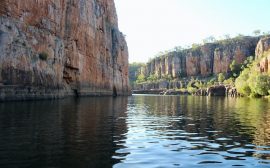Journey for two hours south west of Darwin and you will come across the expansive majesty of the Litchfield National Park. Although Litchfield National Park is often overshadowed by the more famous, Kakadu National Park, it is actually easier to reach and stunningly beautiful. It is home to many bizarre geological structures and powerful waterfalls, which are increasingly making it a more popular place to visit.
Most of the attractions and landmarks within the park are easily accessible by two wheel drive vehicles on the sealed roads, which makes it a very popular day trip destination for visitors from Darwin. However, the size of the park and the variety of things to do and see make a two or three day holiday easily justifiable and just as enjoyable.
Highly regarded as the gateway to Litchfield, the town of Bachelor is located just on the doorstep of the National Park. Visitors to the park should definitely make a pit stop here to become informed about camping permits in the park and to pick up a map to guide them. There is a range of accommodation options here, to suit any need and budget. Daytrippers can also refuel here and pick up some food, and perhaps while here, spend some time in the Bird Farm or the Coomalie Cultural Centre.
One of the strongest draw cards to the park are its impressively majestic waterfalls. The rocky escarpment of the Table Top Range is speckled with creeks and rivers that descend down its steep slopes in a striking manner. Wangi Falls are the largest in the park, and are hence the most visited. The water crashes into a large plunge pool, sending up a fine spray that coats the thick green rainforest that surrounds the falls, giving it a moist atmosphere. After heavy rain, the amount of water pouring down is very impressive, and normally creates currents in the pool that prohibit swimming so be sure it is safe before taking a dip. There is also an interpretaive nature trail that gives excellent views of the falls, and informs you about the local flora and fauna.
Wangi is a good place to base yourself in Litchfield, as there is a a large camping ground here with toilet and shower facilities. A small kiosk has limited supplies, and there are barbeque facilities here as well. A great place to stay!
There are a total of four large waterfalls in the Table Top Range that are frequently visited by the rain, and in the monsoon season a spectacular volume of water crashes down the sheer rock faces. In the drier months they slow to a gentle flow, sometimes even drying up completely so to avoid disappointment, make sure you don’t visit during these times.
Wangi is a spring fed waterfall, so it flows the whole year round. Another spring fed waterfall popular amongst visitors is Florence Falls. Here, two seperate flows of water cascade into a large swimming pool. There is a camping ground here as well, and a walking trail will take you to lookout points that provide a bird’s eye view of the falls and the stunning surrounding region. Peaceful and picturesque, many people stay here a night or two simply to unwind and relax next to the water.
Nearby is the famous Buley Rockhole, where the river flows through a series of small waterfalls that come to a rest in small spa-like pools. The pools are perfect for swimming, and there is a lot of fun to be had in the fast flowing white water of the falls.
Litchfield is also home to some strange yet uniquely amazing structures that are testament to the power and wonder of nature. The Lost City, which is only accessible by four wheel drive, consists of tall, perpendicular sandstone pillars that rise out of the earth in an eerie fashion. Carved out of the soft surrounding rock, these have been shaped by the wind and the rain over the course of thousands of years. They look like some sort of ancient skyscraper, hence the name of ‘Lost City’.
Another attraction that looks similar to these, but are relatively smaller, are the magnetic termite mounds. Seventeen kilometres from the eastern boundary of the park, each of these tall pillar-like anthills is a creative natural wonder, with tunnels, nurseries, chimneys and insulation. They have been aligned from north to south to minimise exposure to the sun and create optimum conditions for the termites to reside in. There is a boardwalk that allows you to get close to these amazing anthills without damaging them. This is a truly unique place to visit.
Amongst nature’s beauty there is also a reminder of the tough life that the pioneers lived, in the form of the Blyth Homestead. These are the remaining ruins of an abandoned homestead, and are a powerful illustration of how remote and inaccessible life was for the generations before us. There are also ruins of tin and copper mines at Bamboo Creek tin mine, which operated for several decades before closing down in the fifties. What is left is still in a fairly decent condition and is definitely worth a look.
Litchfield Park used to be the Northern Territory’s best kept secret. Now, the secret is out, and it is visited by over a quarter of a million people each year. The geological beauty of the rugged landscapes, the dense flora and the varied fauna means very few of these visitors leave the park disappointed. So next time you are in Darwin or its surrounds, a few days in Litchfield are absolutely essential. A hire car will give you the freedom to explore the park, and if you want to go to its far reaches then a four wheel drive is definitely in order.




